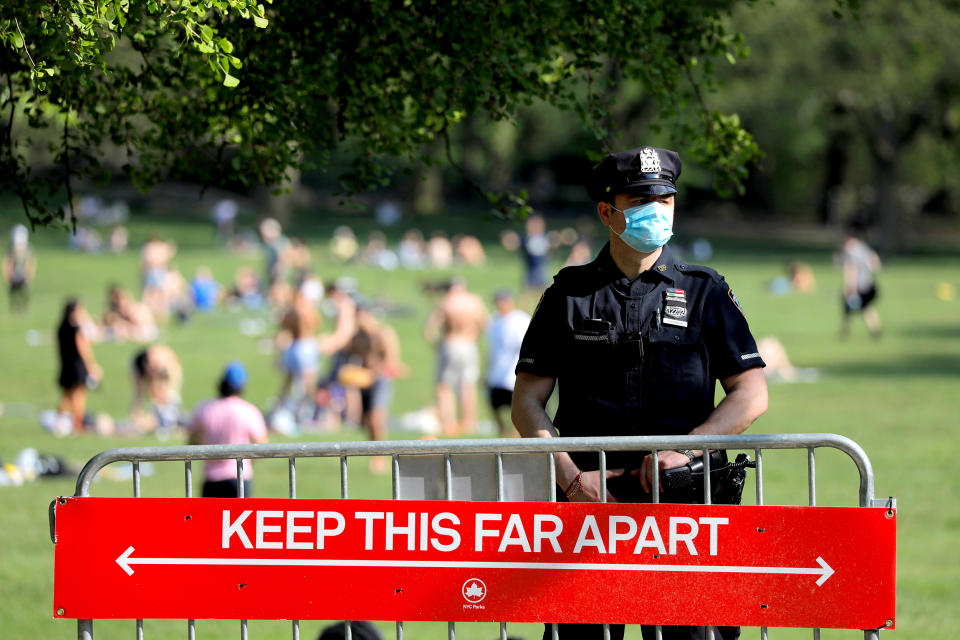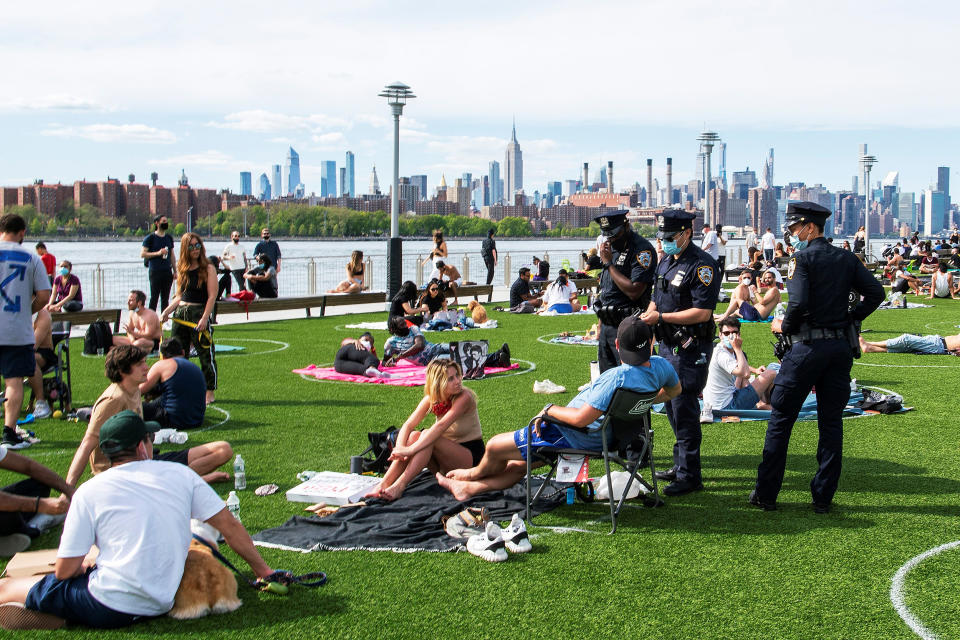Enforcement of social distancing shows familiar pattern of racial disparity, experts say
In New York City, a police officer caught on video appeared to slap, punch and then drag a dark-skinned man. Police said that they had spotted the man filming officers who were arresting a couple for allegedly violating the city’s social distancing orders and that he had taken a “fighting stance.”
In Chicago, police set up checkpoints, checked IDs and barred nonresidents from entering four city blocks with a culture of casual street-corner gatherings and, police say, open-air drug markets. The area’s population is mostly black, and civil liberties advocates questioned the legality of singling out one neighborhood. But police say disrupting all gatherings is part of their new public health mandate.
And in Philadelphia, police dragged a black man from a city bus after he failed to comply with a city order requiring masks on public transit. Police say the man was removed, pressed into the side of a bus and arrested after ignoring and resisting commands. But another man who had created a face covering out of clothing, consistent with CDC recommendations in the absence of a mask, was also ordered off the same bus.
As states and cities across the country have modified social distancing orders into a patchwork of recommendations and requirements, many are paying increased attention to how and where social distancing orders are being enforced. And some experts say a pattern, based on anecdotes and available data, is emerging showing that different standards are being applied for different groups.
The homeless, people in low-income neighborhoods and people of color wherever they congregate face disproportionate enforcement of social distancing rules, which sometimes ends in arrest, armed police response in crisis uniform and physical takedowns, according to experts. What limited data can be gleaned from the nation’s five largest cities — New York, Los Angeles, Chicago, Houston and Phoenix — begins to outline a picture of uneven enforcement.

But what’s happening with social distancing enforcement mirrors broader patterns in policing, who is most agressively monitored, handled when coming in contact with police and then penalized, according to multiple police accountability, civil rights and civil liberties advocates.
Data provided to NBC News by the New York Police Department show that from mid-March to mid-May, about 81 percent of all citations for social distancing violations were issued to black or Latino individuals, although only about half the city’s population are black or Latino.
But in the spaces in New York and other cities around the country where mostly white people gather, they appear free to sunbathe and picnic, with the occasional police offer of a mask, or even crowd together in small pools. And Americans have watched overwhelmingly white anti-social distancing protesters shove, scream and arm themselves at rallies in state capitals. There, they’ve faced-off with police who were not wearing riot gear, and yelled about alleged tyranny.
“We’ve just started seeing more and more incidents happen,” said Lynda Garcia, director of the policing campaign at the Leadership Conference on Civil and Human Rights. “We recognize this is unprecedented. We don’t necessarily have the answers, and law enforcement doesn’t have the answers. But we do think we need to put our heads together to reduce the disparities we’ve already seen in the arrests and stops because this is not a public health response to this epidemic. Arresting someone and putting them in jail is the opposite of social distancing.”
Last week, a collective led by the Leadership Conference released a set of guidelines they believe the nation’s more than 18,000 federal, state, county and local policing agencies should follow. It includes recommendations such as “Stop criminalizing vulnerable communities” and “Prioritize bias-free policies and practices.” A handful of professional associations for police officers also signed the document in support.
Data made available by the NYPD shows that from March 16 to May 10, 374 citations without arrests were issued for social distancing violations. Of these, 51 percent were issued to black people and nearly 30 percent to Latinos.
Also during that time, 66.4 percent of those arrested in “COVID-19-related matters,” as defined by the NYPD, were black and 24 percent were Latino. In comparison, 7.2 percent were white and 2.4 percent Asian. Those numbers contrast dramatically with the racial makeup of the city’s population. The NYPD said these were not social distancing enforcement actions but responses to hate crimes, domestic violence, weapons possession and altercations in which the coronavirus figured prominently, police said.
“One arrest even included a bank robber who presented a note to a teller that said, ‘This is a bank robbery, I have COVID,’” police said in a statement emailed to NBC News.
In a mid-May press conference Police Commissioner Dermot Shea reacted angrily when asked about differences in social distancing enforcement activity during a city COVID-19 crisis briefing.

"I will push back strongly on any notion that this is business as usual for the NYPD or that this is quote unquote racist policing,” he said.
What’s happened so far in the city echoes a familiar pattern, some police accountability advocates say.
“The NYPD’s approach to social-distancing enforcement is stop and frisk 2.0,” Darius Charney, senior staff attorney at the Center for Constitutional Rights, said in a statement Tuesday. The organization, represented in court by Charney, brought the suit that prompted a judge to rule that the NYPD’s use of “stop-and-frisk” policing tactic was unconstitutional.
“But since the court ruling in 2013,” Charney continued in the statement, “the NYPD has continued to stop and frisk minorities at an alarmingly disproportionate rate. This latest activity, under the veil of social-distance enforcement, shows there is a racist double standard happening across the boroughs and that is it business as usual for the NYPD.”
In Los Angeles, there have been no arrests for social distancing violations, in keeping with a mayoral order. Instead, officers “advise, admonish, seek voluntary compliance,” then “write an application for complaint,” the city’s police public information office said in an email. Police have forwarded 102 social distancing complaint applications to the city attorney. They all involve businesses.
"The Los Angeles Police Department is consistent in the way we enforce the Mayor’s 'Safer at Home' Directive," LAPD spokesman Josh Rubenstein told NBC News in an April email.
In recent months, Los Angeles police have broken up large gatherings of mostly black crowds, including one in a park where officers arrived in riot gear. The South L.A. parties "were 'disturbance' calls for service and not random enforcement of the 'Safer at Home' directive," Rubenstein said.
A similar approach was adopted to break up a group of mostly Latino protesters focused on immigrant detention conditions in San Diego. But images have shown other protests opposing stay-at-home orders — almost all white groups in San Diego, Sacramento and various cities in Orange County — going undisturbed based on an apparent lack of arrests or citations. And reports of police efforts to break up largely white crowds in Los Angeles parks have been scant.

In Chicago, from the start of social distancing orders in March through May 19, police ordered 9,026 people to disperse from gatherings, 43 were issued citations with a likely fine and 24 were arrested. NBC News reached out to the Chicago Police Department, which said a racial breakdown of those ordered to go their separate ways, arrested and cited was not immediately available but would be provided after a public information request. The department’s response to that request is outstanding.
However, the hyperlocal online publication Block Club Chicago reported this week that in response to a similar request for information, the Chicago Police Department provided data for the period from March 20 to May 21. During that time, 13 people were arrested for violating Chicago’s social distancing orders. Of the 13 arrests, 10 of the individuals were black, one was white and two were minors so details from their arrest reports were withheld. The department also issued 13 citations or social distancing violations. Of these, 11 were issued in the city’s predominantly black and Latino districts. The racial and ethnic identities of those ticketed were not made available to the publication.
“The reality is the Chicago Police Department is active and engaged all over the city and doing it with an eye toward equity,” Mayor Lori Lightfoot told the publication, “and I would have it no other way as mayor of this city.”
Law enforcement public information officials in Houston and Phoenix did not immediately respond to requests for detailed information.
A joint poll released last week by the NAACP, the African American Research Collective and the Yale School of Medicine Equity Research and Innovation Center found that nearly 60 percent of black Americans surveyed believe police are not enforcing social distancing measures equitably.
The poll queried 604 black adults from May 1 to May 7 and had an error rate of plus or minus 3.9 percentage points.
Of those polled, 66 percent believed race played a role in how police handled anti-social distancing protesters. And more than 70 percent of every age group said they felt safe wearing a mask in public, but more than a quarter of those 18 to 49 said they did not.

“This particular segment of the black population is interpreting the way that they believe they will be perceived if they wear a mask,” said Henry Fernandez, a principal at the African American Research Collective. “How rules are enforced is shaping what should be health-maintaining habits in communities of color.”
That’s backed up by other findings in the poll. About 62 percent of black Americans surveyed said they were following news about the pandemic closely, 39 percent would like to work from home but can’t, and 15 percent said they had relatives or friends who had died of the coronavirus. About 80 percent favor extending the nation’s social and economic shutdown to assure public health and safety.
Cerelyn “C.J.” Davis, the police chief in Durham, North Carolina, has seen the stories of highly physical encounters between people of color and police over social distancing requirements. They make her worry that the pandemic response will deepen existing tensions between some departments and the communities they patrol. Davis often finds herself at odds with other people in law enforcement when she mentions the reality that racial bias exists in policing. But, she said, she wakes up not in uniform but in the skin of an African American woman, and she’s had experiences that affirm the problem.
“This has had a devastating impact on communities as a whole,” said Davis, president of the National Organization of Black Law Enforcement Executives.
“We are not in a crime-fighting mode right now,” said Davis, describing that as an unfamiliar and sometimes disconcerting state for officers trained to enforce the law. “This is a public health issue where we are supporting the public health cause, to try to suppress COVID-19. … COVID-19 is killing people faster than homicide and suicide right now. But there’s no need to deny that how some officers and agencies have responded to that challenge doesn’t look the same, doesn’t work the same in every community.”
Davis also wants civic leaders — clergy, elected officials, community organizations — to get more involved in social distancing enforcement. Police have been reduced to acting as a lone rules-enforcing parent. The entire world is stressed and anxious about an unanticipated pandemic, and now, it seems, police alone must confront people to ask them not to play basketball on a sunny day, Davis said.
“We really need some others to join us in spreading the word,” she said. “This disease, the effects of it are … agonizing, and it is a very lonely death.”

